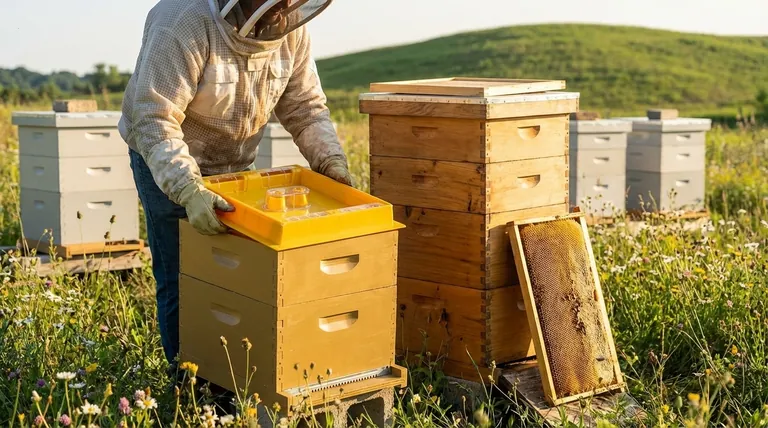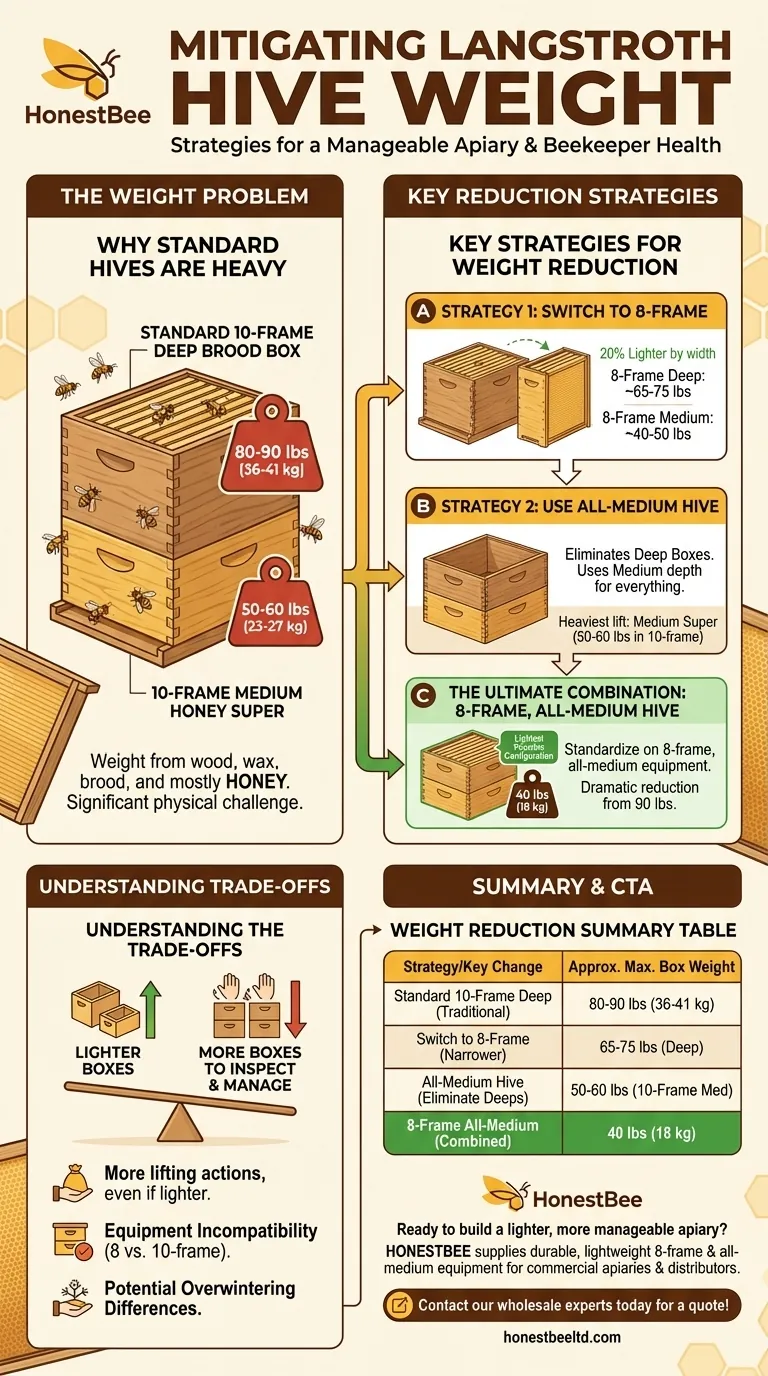To mitigate the weight of Langstroth hives, the most effective strategies are to reduce the box size either by width or by height. This is achieved by switching from standard 10-frame equipment to 8-frame equipment, or by using all medium-depth boxes instead of the heavier deep-depth boxes for both brood and honey.
The core decision is a trade-off: you can choose to lift lighter boxes, but you will have to lift and manage more of them. Understanding this principle is key to designing a hive system that fits your physical capabilities and beekeeping style.

Why Standard Langstroth Hives Are So Heavy
The traditional Langstroth configuration, while popular, presents a significant physical challenge. The weight comes from the combination of wood, beeswax, brood, and most significantly, honey.
The 10-Frame Deep Brood Box
A standard 10-frame deep box is the heaviest component beekeepers are expected to lift. When full of honey, brood, and pollen, this single box can easily weigh 80 to 90 pounds (36-41 kg).
The 10-Frame Medium Honey Super
While lighter than a deep, a 10-frame medium super filled with honey is still a substantial weight. Beekeepers can expect a full medium super to weigh 50 to 60 pounds (23-27 kg). A hive ready for harvest may have several of these.
Key Strategies for Weight Reduction
You can address the weight problem by fundamentally changing the equipment you use. The two primary methods can be used alone or in combination for maximum effect.
Strategy 1: Switch to 8-Frame Equipment
An 8-frame hive has the same depth as a 10-frame but is narrower. This simple change reduces the total weight of any given box by approximately 20%.
A full 8-frame deep box will weigh around 65-75 lbs, and a full 8-frame medium super will weigh 40-50 lbs. This brings hive components into a much more manageable range for most people.
Strategy 2: Use an All-Medium Hive
This strategy eliminates deep boxes entirely. You use medium-depth boxes for everything, including the brood chamber. Two medium boxes are typically used to provide the equivalent space of one deep brood box.
The heaviest single box in your entire hive will now be a medium super, which weighs a maximum of 50-60 pounds in a 10-frame setup.
The Ultimate Combination: The 8-Frame, All-Medium Hive
For the absolute lightest possible configuration, you can combine both strategies. By standardizing on 8-frame, all-medium equipment, the heaviest box you will ever have to lift is an 8-frame medium super.
This box, when full of honey, will weigh approximately 40 pounds (18 kg), a dramatic reduction from the 90 pounds of a standard deep box.
Understanding the Trade-offs
Choosing lighter equipment is not without consequences. It's crucial to understand the compromises you are making.
More Boxes to Inspect and Manage
The most significant trade-off is that smaller boxes mean you need more of them to provide the same total volume for the colony.
An all-medium hive requires you to inspect two or three brood boxes instead of one or two deeps. This means more lifting actions, even though each lift is lighter.
Equipment Incompatibility
Beekeeping equipment is not cross-compatible between 8-frame and 10-frame sizes. Once you commit to one size, you must stick with it for all your woodenware (boxes, bottom boards, covers).
This can be a challenge if you plan to buy established hives (nucs) from other beekeepers, who most commonly use 10-frame equipment.
Potential Overwintering Differences
A narrower 8-frame hive has a different thermal profile than a 10-frame hive. While bees successfully overwinter in 8-frame hives in most climates, the colony has slightly less insulation and food storage capacity on each level.
Making the Right Choice for Your Apiary
Your decision should be based on your physical health, beekeeping goals, and local climate.
- If your primary focus is maximum weight reduction: Standardize on an all 8-frame, all-medium hive setup to ensure no single box exceeds 40-45 pounds.
- If you want a balance of fewer boxes and manageable weight: A 10-frame, all-medium hive is an excellent compromise, capping your maximum lift at around 60 pounds.
- If you are already invested in 10-frame deep equipment: You can still manage the weight by never lifting a full box. Instead, work the hive by removing and inspecting one frame at a time.
By consciously choosing your equipment, you can create a beekeeping practice that is both productive for the bees and physically sustainable for you.
Summary Table:
| Strategy | Key Change | Maximum Box Weight (Approx.) |
|---|---|---|
| Standard 10-Frame Deep | Traditional Setup | 80-90 lbs (36-41 kg) |
| Switch to 8-Frame | Narrower Boxes | 65-75 lbs (Deep) |
| All-Medium Hive | Eliminate Deep Boxes | 50-60 lbs (10-Frame Medium) |
| 8-Frame All-Medium | Combined Strategy | 40 lbs (18 kg) |
Ready to build a lighter, more manageable apiary? At HONESTBEE, we supply durable, lightweight 8-frame and all-medium beekeeping equipment perfect for commercial apiaries and distributors. Let us help you design a hive system that fits your physical needs and operational goals.
Contact our wholesale experts today to discuss your equipment needs and get a quote!
Visual Guide

Related Products
- Professional Hive Top Bee Feeder for Beekeeping
- Professional In-Hive Bee Feeder HONESTBEE Frame for Beekeeping
- Long Langstroth Style Horizontal Top Bar Hive for Wholesale
- JZBZ Langstroth Queen Rearing Frame for Beekeeping
- Multi-Functional Sliding Hive Entrance for Beekeeping
People Also Ask
- Why is a top feeder essential for bees? Ensure Colony Health and Efficiency
- How is the plywood floor fitted into the hive-top feeder? Ensure Longevity with a Floating Floor Design
- What is a top feeder for bees? Maximize Colony Health with Efficient Feeding
- How to use a top feeder in a beehive? A Guide to Effective Beehive Feeding
- What types of hive boxes is the round hive top feeder compatible with? Universal Fit for 8 & 10-Frame Langstroth Hives



















